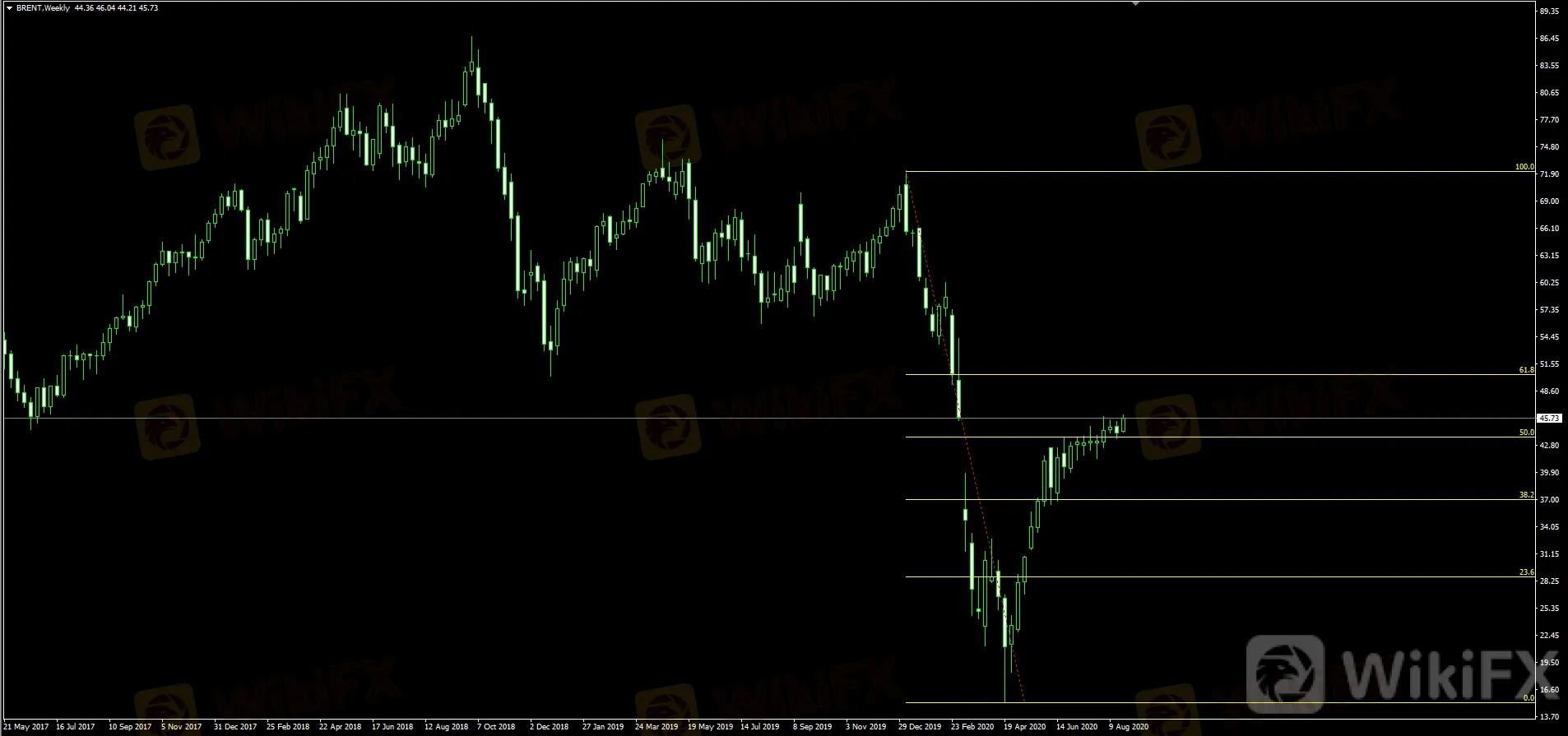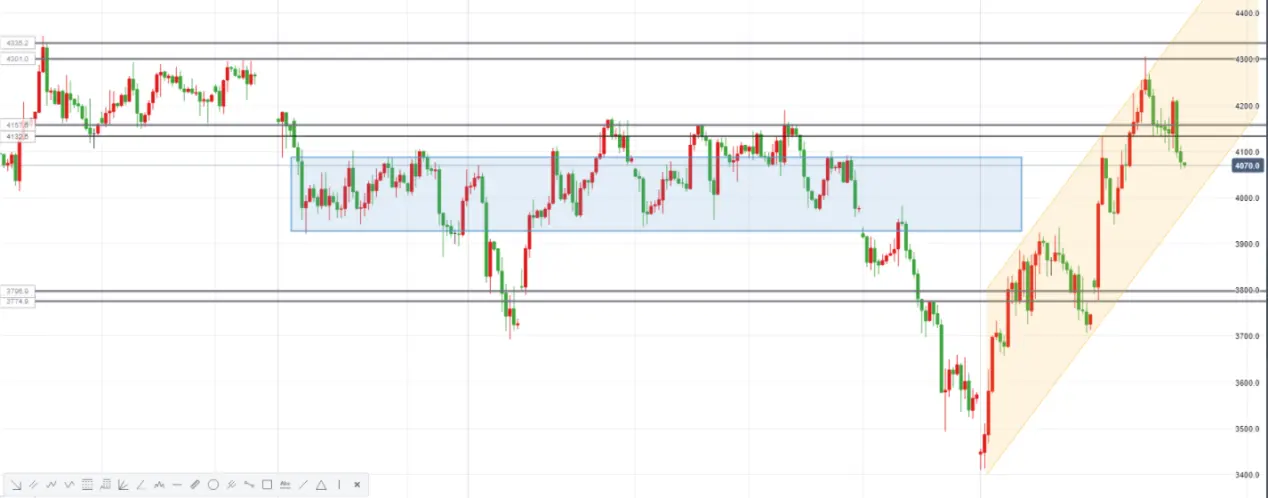简体中文
繁體中文
English
Pусский
日本語
ภาษาไทย
Tiếng Việt
Bahasa Indonesia
Español
हिन्दी
Filippiiniläinen
Français
Deutsch
Português
Türkçe
한국어
العربية
WTI Crude Oil: Looking for Direction!
Abstract:Although crude oil prices have recovered from their lowest levels since late April recorded during the crisis caused by the COVID-19 pandemic, business leaders and oil industry experts are questioning whether oil demand has really peaked or not.
Although crude oil prices have recovered from their lowest levels since late April recorded during the crisis caused by the COVID-19 pandemic, business leaders and oil industry experts are questioning whether oil demand has really peaked or not.
The outbreak and spread of COVID-19 caused oil prices to plummet, with futures prices dropping to a negative value for the first time in history. The demand for energy consumption fell sharply mainly due to governments‘ measures of lockdown and social distancing orders that restricted people to travel and put countries’ aviation industry into a battle to survive.
The International Energy Agency (IEA) forecasts global oil demand will decrease by an average of 8 million barrels/day this year, or about 8% lower than last year. Although the IEA estimates oil demand will increase by 5.7 million barrels/day next year, overall demand will remain lower than in 2019 due to ongoing uncertainty in the aviation sector.
This gloomy outlook has made many observers question whether market demand can return to 2019 levels? The concept of oil at its peak has long been the subject of discussion. Experts mainly focus on production peaks, with forecasts that oil prices will skyrocket when underground oil resources are exhausted.
But in recent months, the concept of a demand peak has emerged, after the COVID-19 pandemic wiped out the fuel demand of the transport industry, plus those efforts to move to cleaner fuel sources. Environmental groups have been campaigning to stop the Paris Agreement on climate change from becoming another victim of the COVID-19 pandemic, said Professor Michael Bradshaw at the Warwick Business School (UK), at the same time emphasized the need for a Green New Deal in the economic recovery process.
Professor Bradshaw argues that if environmental groups succeed, demand for “black gold” may never return to the highest levels ever recorded before the COVID-19 pandemic. Meanwhile, the transport sector may never fully recover, and after a pandemic, people may have different attitudes toward international air travel or work habits.
According to IEA CEO Fatih Birol, many people including CEOs of several large companies think that with today's lifestyle changes, oil demand may have peaked and will begin to drop. Meanwhile, the oil industry may face financial challenges.
Bronwen Tucker, an analyst at the non-governmental organization Oil Change International (OCI), said the oil industry is under great pressure from investors. “The giant” Royal Dutch Shell (UK-Netherlands) said last week that the asset value of this business has decreased by about 22 billion USD when reassessing the value of the business under the influence of COVID-19. Last month, Britain's BP also announced the net worth of the oil and gas conglomerate decreased by $ 17.5 billion. While China actively buys crude oil when it is so cheap and so that the tanker congestion has formed at sea.
China is currently the world's second largest oil consumer after the US. As of June 29, the country has accumulated 73 million barrels of oil, which is stored in 59 ships floating at sea, according to data from ClipperData - the company tracks the movement of crude oil at sea in real time. This is equivalent to three-quarters of the world's demand.
The recently landed oil was probably purchased in March and April, when oil prices plummeted due to the pandemic. WTI US crude oil dropped to negative on April 20 for the first time in history.
China's floating oil storage - which includes barrels of oil waiting on board for seven days or more - has nearly quadrupled since the end of May, according to ClipperData. This is not only a record number since the beginning of 2015, but also 7 times higher than the monthly average in the first quarter of 2020.
The storage of oil at sea shows that China is making a profit when the world energy market falls into a period of extreme crisis. “China is buying massive globally,” said Matt Smith, director of cargo strategy at ClipperData. “The number of oil at sea is growing rapidly.”
Smith also said China's inland oil depots were not even filled yet. “This was simply due to an out-of-port congestion. So many tankers arrived that they couldn't bring it ashore in time,” he explained.
The main buying power of China has partly pulled up the oil market. Just 7 weeks after falling to a negative of nearly $40, US crude oil rose again to $40 a barrel. The difference of 80 cent USD was created by the unprecedented reduction in production by OPEC and Russia, the world lockdown situation was loosened and demand from China increased sharply.
China is currently the world's second largest economy. They have to rely on imported crude oil to maintain economic activity. That is why the country has to hoard oil when prices bottom out.
According to S&P Global Platts, China's oil imports were up 19% in July from the same period last year, to 11.3 million barrels per day. August figures are forecasted to be even higher.
Most of this oil comes from Latin America. Brazil is the main source of China's floating oil depots, according to ClipperData. The transportation of oil from here to China takes about 1.5 months. The remainder comes from countries such as Iraq, Saudi Arabia and Nigeria.
Of course, China is not the only country to take advantage of the times of cheap oil to buy reserves. “If you are a big consumer, you will find ways to buy oil,” said Ryan Fitzmaurice - energy strategist at Robobank.
When oil prices fell in freefall in March, the administration of US President Donald Trump pledged to assist US crude producers in“facing the risk of heavy losses” by purchasing 30 million barrels of oil to supplement to be added to the strategic Petroleum Reserve. However, Chinese buying volume overwhelms other countries. “China is the only crazy buying country,” Smith said.
In addition to its obvious advantages in energy security, Chinese jobs also have financial incentives. The oil market earlier this year fell into contango - future prices are higher than current prices. This creates great speculative opportunities for those who stockpile oil for several months, then sell it for a profit. “Why sell oil when it's at -40 dollars when you can sell it just a month later for $40?” Said Louise Dickson, an analyst at Rystad Energy. The storage crisis has prompted energy companies and investors this year to start using ships, not for shipping but for oil. This caused the cost of chartering a large boat (which can hold 2 million barrels) more than doubled, to $15 million for a trip from the US Gulf of Mexico coast to China in late April, according to Rystad. “Now that the space panic subsides, there is no need for large ships,” Dickson said. China also recently began to reduce its crude oil imports, Smith said. “They have been supporting prices for the past few months and they can do the opposite in the coming months,” he said.
W1 frame:
Looking at the W1 weekly frame (Figure 1) we can see that oil prices are trading around the Fibonacci 50 zone, although about a month ago the price went sideways below the 50 Fibonacci zone, but since the last month, the price experiences a breakout of the Fibonacci 50 resistance-turnaround zone supported by Fibonacci 50, which shows an optimism among investors.

Figure 1
D1 Frame:
You may still remember April 22 for the first time in world history that oil futures were trading even below negative, and also since the end of April, oil prices have recovered rapidly until early now. It was slightly down on fears that the second wave of COVID-19 could make the price below $36.84/barrel. And until now, although there are waiting for slight corrections, char's path is increasing - reflected in waiting for the waves to rise and the bottom is higher than the old top and bottom.

Figure 2
H1 Frame:
For the H1 frame (Figure 3), the price increased again after the oil price had a slight decrease before hitting the lower trend line. Currently, prices are moving sideways to accumulate after breaking the previous peak of 45.92 USD/barrel to prepare for the next breakout, typically every time the price drops to 45.53 USD/barrel, it bounces up. If the price does not step down in the near future, it is entirely possible that the price will be skyrocketing.

Figure 3
Disclaimer:
The views in this article only represent the author's personal views, and do not constitute investment advice on this platform. This platform does not guarantee the accuracy, completeness and timeliness of the information in the article, and will not be liable for any loss caused by the use of or reliance on the information in the article.
Read more

GEMFOREX - weekly analysis
The week ahead: Top 5 things to watch

GemForex | Crude Oil (WTI)
Crude Oil (WTI) - Rebound in the offing?

WTI hits fresh cycle highs in the mid-$63.00s
WTI hits fresh cycle highs in the mid-$63.00s

WTI Breaks Below $41.0 As EIA Cuts Demand Forecast
On Thursday, WTI saw its rally just shy of the intraday high of $42.18 and witnessed choppy downsides before breaching below the support at $41.0 to the intraday low of $40.61, notching two consecutive days of drops.
WikiFX Broker
Latest News
ASIC Sues Binance Australia Derivatives for Misclassifying Retail Clients
Top 10 Trading Indicators Every Forex Trader Should Know
WikiFX Review: Is FxPro Reliable?
Malaysian-Thai Fraud Syndicate Dismantled, Millions in Losses Reported
Trading frauds topped the list of scams in India- Report Reveals
Revolut Leads UK Neobanks in the Digital Banking Revolution
Fusion Markets: Safe Choice or Scam to Avoid?
SEC Approves Hashdex and Franklin Crypto ETFs on Nasdaq
WikiFX Review: Something You Need to Know About Markets4you
Malaysian Pensioner Loses RM823,000 in Fake Investment Scam
Currency Calculator


